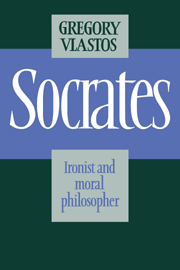Book contents
- Frontmatter
- Contents
- List of additional notes
- Introduction
- 1 Socratic irony
- 2 Socrates contra Socrates in Plato
- 3 The evidence of Aristotle and Xenophon
- 4 Elenchus and mathematics
- 5 Does Socrates cheat?
- 6 Socratic piety
- 7 Socrates' rejection of retaliation
- 8 Happiness and virtue in Socrates' moral theory
- Epilogue: Felix Socrates
- Additional notes
- Bibliography
- Index of passages cited
- Index of names in Plato and Xenophon
- Index of modern scholars
- Index of Greek words
- Frontmatter
- Contents
- List of additional notes
- Introduction
- 1 Socratic irony
- 2 Socrates contra Socrates in Plato
- 3 The evidence of Aristotle and Xenophon
- 4 Elenchus and mathematics
- 5 Does Socrates cheat?
- 6 Socratic piety
- 7 Socrates' rejection of retaliation
- 8 Happiness and virtue in Socrates' moral theory
- Epilogue: Felix Socrates
- Additional notes
- Bibliography
- Index of passages cited
- Index of names in Plato and Xenophon
- Index of modern scholars
- Index of Greek words
Summary
“Irony,” says Quintilian, is that figure of speech or trope “in which something contrary to what is said is to be understood” (contrarium ei quod dicitur intelligendum est). His formula has stood the test of time. It passes intact in Dr Johnson's dictionary (“mode of speech in which the meaning is contrary to the words” [1755]), and survives virtually intact in ours: “Irony is the use of words to express something other than, and especially the opposite of, [their] literal meaning” (Webster's). Here is an example, as simple and banal as I can make it: a British visitor, landing in Los Angeles in the midst of a downpour, is heard to remark, “What fine weather you are having here.” The weather is foul, he calls it “fine,” and has no trouble making himself understood to mean the contrary of what he says.
Why should we want to put such twists on words, making them mean something so different from their “literal” – i.e. their established, commonly understood – sense that it could even be its opposite? For one thing, humour. For another, mockery. Or, perhaps both at once, as when Mae West explains why she is declining President Gerald Ford's invitation to a state dinner at the White House: “It's an awful long way to go for just one meal.”
- Type
- Chapter
- Information
- SocratesIronist and Moral Philosopher, pp. 21 - 44Publisher: Cambridge University PressPrint publication year: 1991
- 2
- Cited by



